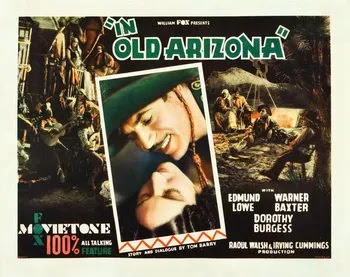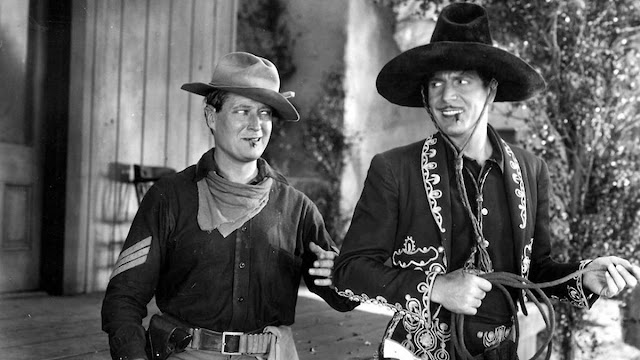I watched In Old Arizona twice before sitting down to write about it. There was a reason for my decision to do this when most other films I just watch once and take detailed notes, then write my feelings about them. It wasn’t because I felt the film was amazing and needed a second viewing nor was it particularly complex and needed to be rewatched to sort out the plot. The reason I went back was because I learned something about this film after watching it that colored how I should be looking at it and necessitated I go into it with a slightly different point of view.
I should have realized from the start that, this film being produced and released in 1928, it would be on the edge of the new sound technology and that filming it in a largely outdoor environment would have been a herculean effort, necessitating new processes to be invented to make it happen. That it came out as polished as it did is amazing. Watching it a second time I could better appreciate what was accomplished even if I still don’t think the film itself is all that entertaining.
In Old Arizona is a cat-and-mouse story about an army sergeant, Micky Dunn (Edmund Lowe), who has been tasked by his superior to bring in a bandit, the Cisco Kid (Warner Baxter). The Cisco Kid has just recently robbed a Wells Fargo stagecoach of its gold box and Dunn has been ordered to capture him, dead or alive. The reward for this: $5,000. The two rivals meet initially at a barber shop where the Cisco Kid is getting cleaned up, but Dunn doesn’t recognize him, mistaking him for a friendly civilian. When he leaves, the local blacksmith tells Dunn who that was, much to his chagrin.
The Cisco Kid is in a romantic relationship with Tonia Maria (Dorothy Burgess), visiting her often and bringing her gifts. Unbeknownst to him, she is often having affairs with other men. This will later include Dunn, who uses his influence on her, as well as her greed for the reward money, to betray the Cisco Kid and set him up to be killed. But the Cisco Kid overhears her plans and makes plans of his own to turn the tables on them both and escape certain death.
When talking pictures first began to roll out, the biggest problem, beyond equipping theaters to show them, was in capturing the sounds while filming them. Cameras had to be mounted stationary inside a small soundproof room on a soundstage, and microphones were placed somewhere around the actor, who then had to make sure they were speaking in the right direction so that it could be properly picked up at the time of the performance. This left many of the earliest talking films feeling stilted, and it hampered creativity to a degree. Many actors couldn’t transition to the new way of making films and found their way of life coming to an end. Others flourished in the new medium and stayed prolific well into the talking era.
One thing these new talking pictures couldn’t do, initially, was be in a relatively uncontrollable environment. They needed the soundstages and the soundproofing. They needed the rigid camera in a closed booth because otherwise, the microphones would pick up the loud noises of the camera as reels of film were cranked through it. In Old Arizona was a pioneer in the field of outdoor talking films. The unfortunate effect of this, however, is that later films would take the technology and innovations and do it better. When watching this film now, one of the big things that does stand out is the poor sound quality, often drifting in and out of clarity. This film is now in the public domain, so there is little motivation to use modern technologies to fix this sound mix. The plus side of being in the public domain is that the film is readily available to anyone who wishes to see it.
Warner Baxter won an Oscar for his performance as the Cisco Kid, and it’s easy to see why. His performance is one of the real treats of this film: easygoing, suave, rascally, yet he has a moral code he doesn’t step over. When we are first introduced to him, he is robbing a stage coach. Yet he doesn’t rob any of the passengers, nor does he hurt anyone. He has a happy-go-lucky nature that charms the women even as he holds a gun on them. He is a villain, but he doesn’t come across as a violent man. Even when he realizes he is being betrayed by Tonia Maria, his solution doesn’t require him to directly assault her, yet the final result remains the same. This character was so popular amongst audiences at the time that Warner would reprise the role for three sequels as well as other cameos.
Dorothy Burgess is playing up the part of the gold-digging betrayer, overplaying it from the start. This is far from subtle, feeling more like a performance for a silent feature. We get her character from her first scene as she’s sneaking a man out of her room while playing the dedicated girl to the Cisco Kid. She is a vain woman who cares about two things: men and money. She is quick to get offended when a man doesn’t fall for her immediately and is quick to turn traitor on the Cisco Kid when she is offered all the reward money if she sets him up. Consequently, no tears are shed when she meets her end.
This film is a good example of Hollywood at a crossroads as they slowly learn how to make films in this new medium. It’s not a great film, but it is an important one. That is a major reason it got so much recognition at the 2nd Annual Academy Awards. It has pacing issues, with certain scenes going on for far too long, and the acting is hit-or-miss. Warren comes out as the only performance worth noting; Edmund Lowe is just bland and uninteresting. It also made popular the singing cowboy trope that was still popular well into the 1950s. As a story, though, it leaves much to be desired and doesn’t justify the runtime. As a whole, this is an interesting film for fans of early Hollywood movie history but is not much else.
Academy Award Nominations:
Outstanding Production: Winfield Sheehan
Best Director: Irving Cummings
Best Actor: Warren Baxter (won)
Best Writing: Tom Barry
Best Cinematography: Arthur Edeson
____________________________________________________
Release Date: January 20, 1929
Running Time: 95 Minutes
Not Rated
Starring: Warner Baxter, Edmund Lowe, and Dorothy Burgess
Directed By: Irving Cummings and Raoul Walsh








Comments
Post a Comment